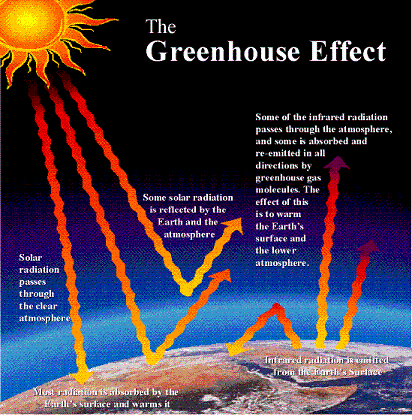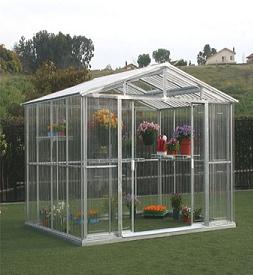
INCOMING!
The sun's energy comes to earth as solar radiation in short and medium wavelengths.
- Most are short wave radiation which are absorbed by the mid to high regions of the atmosphere to earth.
- Medium waves are visible light and travel pretty much uninterruped through the atmosphere to earth.
- These waves are absorbed by the earth's surface and, by the carbon dioxide and vapor in the lower atmosphere.
SOME GETS REFLECTED
31% of the incoming visible light is reflected back into space
- 22% = clouds + suspended solid materials
- 9% = land + ocean surfaces particularly ice and snow
AND SOME GETS ABSORBED
69% sun's visible light that gets through
- 49% absorbed mostly by land and water on the earth's surface
- 20% clouds and atmosphere
AND RELEASED LATER
Heat absorbed by the surface is radiated back as long wave infrared (IR)
radiation. This warms the air immediately above the earth's surface.
TO BE TRAPPED AGAIN- FOR A WHILE
Water vapor and other greenhouse gases in the atomosphere absorb this IR
radiation holding it in. The trapped heat is also radiated up, down
and all around. Eventually it disperses to outer space. This is
called the GREENHOUSE EFFECT because the atmosphere acts like
the glass in a greenhouse. It helps to trap in the sun's heat, slowing
its release into the colder space. However, too much or too little of
a good thing can be bad for you. We need just the right balance of
GHGs in the atmosphere. This means that more heat is being trapped by
the atmosphere and, our greenhouse is starting to get a little too warm
for comfort.

Conclusion:
Without this natural greenhouse effect, the earth would be much colder than it
is now- about 33 degrees Celsius colder, making the average temperature
on the planet a freezing -18 degree Celsius. The warmth of our climate
is crucial because on earth and in the atmosphere, water can exist in
all three of its phases:
- frozen as snow or ice
- liquid as water
- gaseous as water vapor
The cycling of water from one phase to another is critical to sustaining
life since, it is this cycling of water through the land, ocean and
atmosphere system, that replenishes the water available to life on
earth. The water cycle is also an important part of what drives our
weather and the climate system generally.


